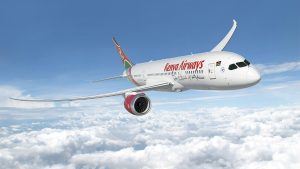The International Air Transport Association (IATA), projects that airlines will earn $4.7b in profits off gross industry revenues of $779b in 2023.
As the global aviation industry emerges from the deep impacts of the Covid-19 pandemic, the world’s airlines are projected to post their first profits since 2019. Globally, airlines lost $7b in 2022, an amazing comeback from the $42b they lost in 2021 and sh138b the year before.
The International Air Transport Association (IATA), projects that airlines will earn $4.7b in profits off gross industry revenues of $779b in 2023. That will be driven by a more rational approach to Covid-19 restrictions, higher levels of vaccination against the virus and a better match between capacity and demand for travel.
Because of a large domestic sector and earlier easing of internal pandemic controls, North America is leading the return to profitability. North American airlines were expected to post a profit last year. It will be followed by Europe and the Middle East this year. All factors remaining constant, airlines in Latin America, Africa and the Asia Pacific region, could see their first profit, post-pandemic, from 2024 onwards.
For startups like Uganda Airlines, the Covid-19 pandemic could not have come at a worse time. The global lockdowns set in a mere six months after the airline had started commercial operations. When the breaks were suddenly pulled on international travel, network development, passenger traffic and revenues all took a hit. All the initial business assumptions on which Uganda Airlines’ performance projections were based, were also turned on their head.
It had been projected that the carrier would be operating 16 routes at the end of the first year; only 10 had been activated at the time lockdowns intensified in March 2020. To date, only 11 routes, including a single intercontinental route are operational instead of 18, including three international routes. Besides shredding revenue projections, the lockdowns and the conflict in Ukraine, also imposed unexpected costs on the carrier. Globally, the average cost of jet fuel as a proportion of airline costs during 2022, doubled to 24%. As an Africa-based operator without a hedging scheme, Uganda Airlines saw much steeper fuel- cost escalation.
Despite that turbulent start, the business is now looking up as travel restrictions ease and air travel normalizes. The schedule has recovered and in the near future, operations are expected to revert to pre-Covid-19 levels. We are actively pursuing network expansion and there will be some exciting announcements soon.
The gap between the projections and performance is also narrowing. During fiscal 2021/22, some 218,788 passengers were carried against a target of 383,486 passengers. Although that was 43% short of target, it represented a 148% increase in passenger numbers over the 2020/21 accounting period. At the operational level, (the number of routes in operation), the shortfall was 29%.
Over the same period, we saw a 172% increase in passenger revenues relative to fiscal 2020/2021 and the budgeted shortfall on active routes only was 25%. The passenger load factor improved by seven points to reach 45%. Revenues from charter operations expanded 115% over 2020/2021.
Reason for optimism?
Uganda Airlines fortunes are closely tied to the performance of Africa as a region. That is because most of its and nearly 87% of its frequencies are within Africa.
Tourism data also shows that Uganda sources 80% of its tourists from Africa. By inference, better performance by Africa implies better prospects for Uganda Airlines. According to IATA statistics for December 2022, African airline traffic grew 118.8% over the previous year. Their combined share of the global market rose to 2.1% from 1.9% in 2021.
The carrier will, therefore, see stronger passenger performance as it expands its African network and integrates it with new routes to Asia and Europe to achieve its hub and spoke. Flying to West Africa is going to be important in this regard. The opening up by China after years of tight restrictions also bodes well for global travel and Uganda Airlines. The regional points will feed our global network and that is the big picture.
Value of aviation to the Ugandan economy
While air transport’s contribution to Uganda’s economy has not been comprehensively studied, aggregate figures from elsewhere, provide a rough picture of its potential contribution; the contribution of aviation is usually fused under the transport sector. In 2019 for instance, with Africa accounting for only 3% of global passenger traffic, aviation contributed $63b to the continent’s GDP and employed 6.2m people.
According to studies by IATA, air transport contributed $3.2b or 4.6% of Kenya’s GDP and supported 410,000 jobs in 2017. That output was based on the 4.8 million foreign passengers that passed through Kenya that year. The sector’s contribution was projected to expand to $11.3b, supporting an estimated 859,000 jobs by 2037, if market trends were to remain constant.
At the end of 2017, Kenya was connected to 67 destinations served by 32 airlines. The corresponding figures for Uganda are 27 destinations in 17 countries served by 17 scheduled carriers.
In Uganda, at least 1.5 million passengers travelled to the country by air in 2022. Uganda Airlines accounted for about a third of that figure. The airline also employed 500 people, only 14% of them expatriates. The airline also contributed sh14b to tax revenues and spent close to sh1.2b in payments to local suppliers.
Profit or loss?
While the public conversation about Uganda Airlines tends to paint a grim picture, the numbers above tell a different story. They show that the airline is on a positive trajectory and is indeed clawing back lost territory. It is also important to remember that the airline is still in the investment phase and at this point, costs will outpace revenues.
Airline profitability and loss come at two levels – operational and absolute. Uganda Airlines will continue to post losses at the absolute level because of the imbalance between fixed costs – which decline over the longer term, and the revenue curve in the short term.
Operationally, the airline has been financing some of its operations from revenues generated from passenger operations. Short of unexpected shocks, the airline should achieve operational break-even within the next two to three years, as operations are optimised and market penetration increases.
The major source of cost escalation for Uganda Airlines during the past three years has been stunted passenger growth because of external factors, fleet maintenance costs and sharp increases in the price of aviation fuel because of Ukraine tensions.
African airlines are, however, exposed to much higher prices for aviation fuel because in 2022, refineries were charging African customers a margin of $50. On average, African airlines pay 30% more per litre of fuel, than their counterparts elsewhere. There is good news here, that through African Airlines Association (AFRAA)
Uganda Airlines costs are expected peak this year before starting a gradual decline from next 2024. The major drivers of cost escalation will be the launch of long-haul routes to Europe and the Far-East. However, a rationalized and better integrated network, increased traffic, and better aircraft utilization, will drive costs down.
Source: New Vision






